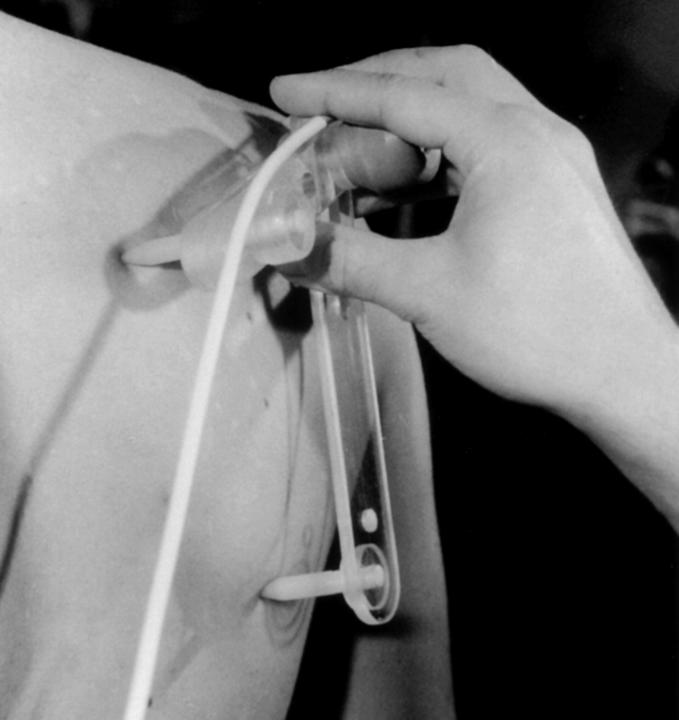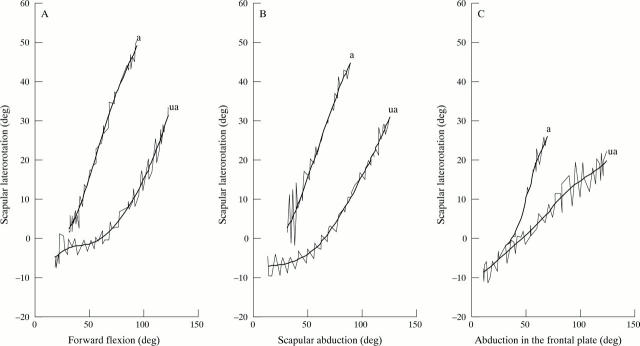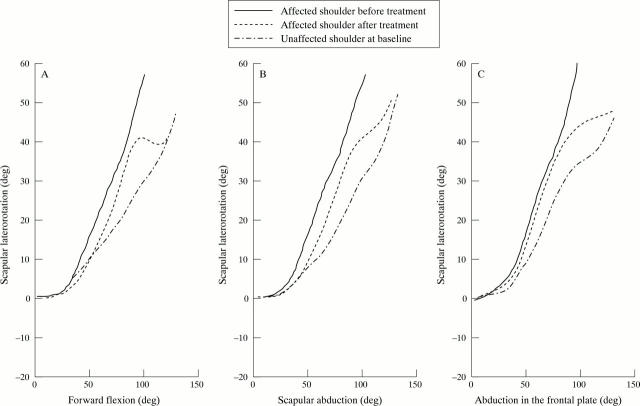Abstract
Objective: To compare three dimensional movement patterns of the affected and non-affected shoulder in patients with a frozen shoulder before and after physical therapy.
Methods: Patients with a unilateral frozen shoulder were assessed before and after three months of treatment. Three dimensional movement analysis was performed with the "Flock of Birds" electromagnetic tracking device while the patient raised their arms in three directions. Slopes of the regression lines of glenohumeral joint rotation versus scapular rotation, reflecting the scapulohumeral rhythm, were calculated. All assessments were made for both the affected and the unaffected side. Additional assessments included conventional range of motion (ROM) measurements and visual analogue scales (VAS) (0–100 mm) for shoulder pain at rest, during movement, and at night.
Results: Ten patients with a unilateral frozen shoulder were included. The slopes of the curves of the forward flexion, scapular abduction, and abduction in the frontal plane of the affected and the unaffected side were significantly different in all three movement directions. Mean differences were 0.267, 0.215, and 0.464 (all p values <0.005), respectively. Mean changes of the slopes of the affected side after treatment were 0.063 (p=0.202), 0.048 (p=0.169), and 0.264 (p=0.008) in forward flexion, scapular abduction, and abduction in the frontal plane, respectively. All patients showed significant improvement in active ROM (all p<0.005), and the VAS for pain during movement and pain at night (p<0.05).
Conclusions: With a three dimensional electromagnetic tracking system the abnormal movement pattern of a frozen shoulder, characterised by the relatively early laterorotation of the scapula in relation to glenohumeral rotation during shoulder elevation, can be described and quantified. Moreover, the system is sufficiently sensitive to detect clinical improvements. Its value in other shoulder disorders remains to be established.
Full Text
The Full Text of this article is available as a PDF (116.5 KB).
Figure 1 .
Palpating angulus acromialis, trigonum spinae, and angulus inferior of the scapula with the scapula locator.
Figure 2 .
Raw data and smoothed curve (thick line) of one patient. a, Affected shoulder; ua, unaffected shoulder.
Figure 3 .
Mean curves of 10 patients.
Figure 4 .
Slopes of 10 patients. HB, Unaffected shoulder at baseline; AB, affected shoulder before treatment; AA, affected shoulder after treatment; thick line, mean slope.
Selected References
These references are in PubMed. This may not be the complete list of references from this article.
- Barnett N. D., Duncan R. D., Johnson G. R. The measurement of three dimensional scapulohumeral kinematics--a study of reliability. Clin Biomech (Bristol, Avon) 1999 May;14(4):287–290. doi: 10.1016/s0268-0033(98)00106-5. [DOI] [PubMed] [Google Scholar]
- Johnson G. R., Fyfe N. C., Heward M. Ranges of movement at the shoulder complex using an electromagnetic movement sensor. Ann Rheum Dis. 1991 Nov;50(11):824–827. doi: 10.1136/ard.50.11.824. [DOI] [PMC free article] [PubMed] [Google Scholar]
- Jordan K., Dziedzic K., Jones P. W., Ong B. N., Dawes P. T. The reliability of the three-dimensional FASTRAK measurement system in measuring cervical spine and shoulder range of motion in healthy subjects. Rheumatology (Oxford) 2000 Apr;39(4):382–388. doi: 10.1093/rheumatology/39.4.382. [DOI] [PubMed] [Google Scholar]
- Lindbeck Lars, Karlsson Dan, Kihlberg Steve, Kjellberg Katarina, Rabenius Kristina, Stenlund Berndt, Tollqvist Jan. A method to determine joint moments and force distributions in the shoulders during ceiling work -- a study on house painters. Clin Biomech (Bristol, Avon) 1997 Oct;12(7-8):452–460. doi: 10.1016/s0268-0033(97)00056-9. [DOI] [PubMed] [Google Scholar]
- Ludewig P. M., Cook T. M., Nawoczenski D. A. Three-dimensional scapular orientation and muscle activity at selected positions of humeral elevation. J Orthop Sports Phys Ther. 1996 Aug;24(2):57–65. doi: 10.2519/jospt.1996.24.2.57. [DOI] [PubMed] [Google Scholar]
- Lukasiewicz A. C., McClure P., Michener L., Pratt N., Sennett B. Comparison of 3-dimensional scapular position and orientation between subjects with and without shoulder impingement. J Orthop Sports Phys Ther. 1999 Oct;29(10):574–586. doi: 10.2519/jospt.1999.29.10.574. [DOI] [PubMed] [Google Scholar]
- Meskers C. G., Fraterman H., van der Helm F. C., Vermeulen H. M., Rozing P. M. Calibration of the "Flock of Birds" electromagnetic tracking device and its application in shoulder motion studies. J Biomech. 1999 Jun;32(6):629–633. doi: 10.1016/s0021-9290(99)00011-1. [DOI] [PubMed] [Google Scholar]
- Meskers C. G., van der Helm F. C., Rozendaal L. A., Rozing P. M. In vivo estimation of the glenohumeral joint rotation center from scapular bony landmarks by linear regression. J Biomech. 1998 Jan;31(1):93–96. doi: 10.1016/s0021-9290(97)00101-2. [DOI] [PubMed] [Google Scholar]
- Meskers C.G.M., Vermeulen H.M., de Groot J.H., van Der Helm F.C.T., Rozing P.M. 3D shoulder position measurements using a six-degree-of-freedom electromagnetic tracking device. Clin Biomech (Bristol, Avon) 1998 Jun;13(4-5):280–292. doi: 10.1016/s0268-0033(98)00095-3. [DOI] [PubMed] [Google Scholar]
- Peterson B., Palmerud G. Measurement of upper extremity orientation by video stereometry system. Med Biol Eng Comput. 1996 Mar;34(2):149–154. doi: 10.1007/BF02520020. [DOI] [PubMed] [Google Scholar]
- Price C. I., Franklin P., Rodgers H., Curless R. H., Johnson G. R. Non-invasive evaluation of shoulder problems after stroke. Lancet. 1999 Jan 23;353(9149):298–298. doi: 10.1016/s0140-6736(05)74928-x. [DOI] [PubMed] [Google Scholar]
- Price C. I., Rodgers H., Franklin P., Curless R. H., Johnson G. R. Glenohumeral subluxation, scapula resting position, and scapula rotation after stroke: a noninvasive evaluation. Arch Phys Med Rehabil. 2001 Jul;82(7):955–960. doi: 10.1053/apmr.2001.23826. [DOI] [PubMed] [Google Scholar]
- Reeves B. The natural history of the frozen shoulder syndrome. Scand J Rheumatol. 1975;4(4):193–196. doi: 10.3109/03009747509165255. [DOI] [PubMed] [Google Scholar]
- Van Herp G., Rowe P., Salter P., Paul J. P. Three-dimensional lumbar spinal kinematics: a study of range of movement in 100 healthy subjects aged 20 to 60+ years. Rheumatology (Oxford) 2000 Dec;39(12):1337–1340. doi: 10.1093/rheumatology/39.12.1337. [DOI] [PubMed] [Google Scholar]
- Vermeulen H. M., Obermann W. R., Burger B. J., Kok G. J., Rozing P. M., van Den Ende C. H. End-range mobilization techniques in adhesive capsulitis of the shoulder joint: A multiple-subject case report. Phys Ther. 2000 Dec;80(12):1204–1213. [PubMed] [Google Scholar]
- de Groot Jurriaan H., Valstar Edward R., Arwert Henk J. Velocity effects on the scapulo-humeral rhythm. Clin Biomech (Bristol, Avon) 1998 Dec;13(8):593–602. doi: 10.1016/s0268-0033(98)00037-0. [DOI] [PubMed] [Google Scholar]
- van der Helm F. C., Pronk G. M. Three-dimensional recording and description of motions of the shoulder mechanism. J Biomech Eng. 1995 Feb;117(1):27–40. doi: 10.1115/1.2792267. [DOI] [PubMed] [Google Scholar]






